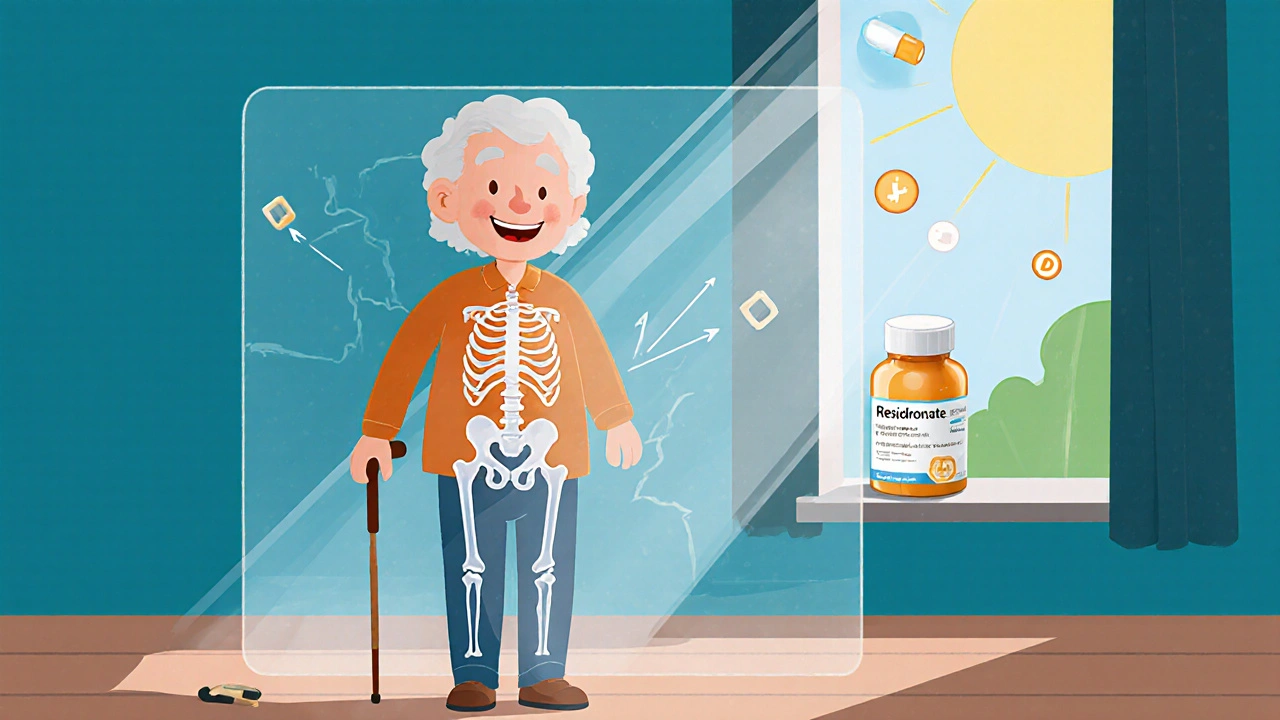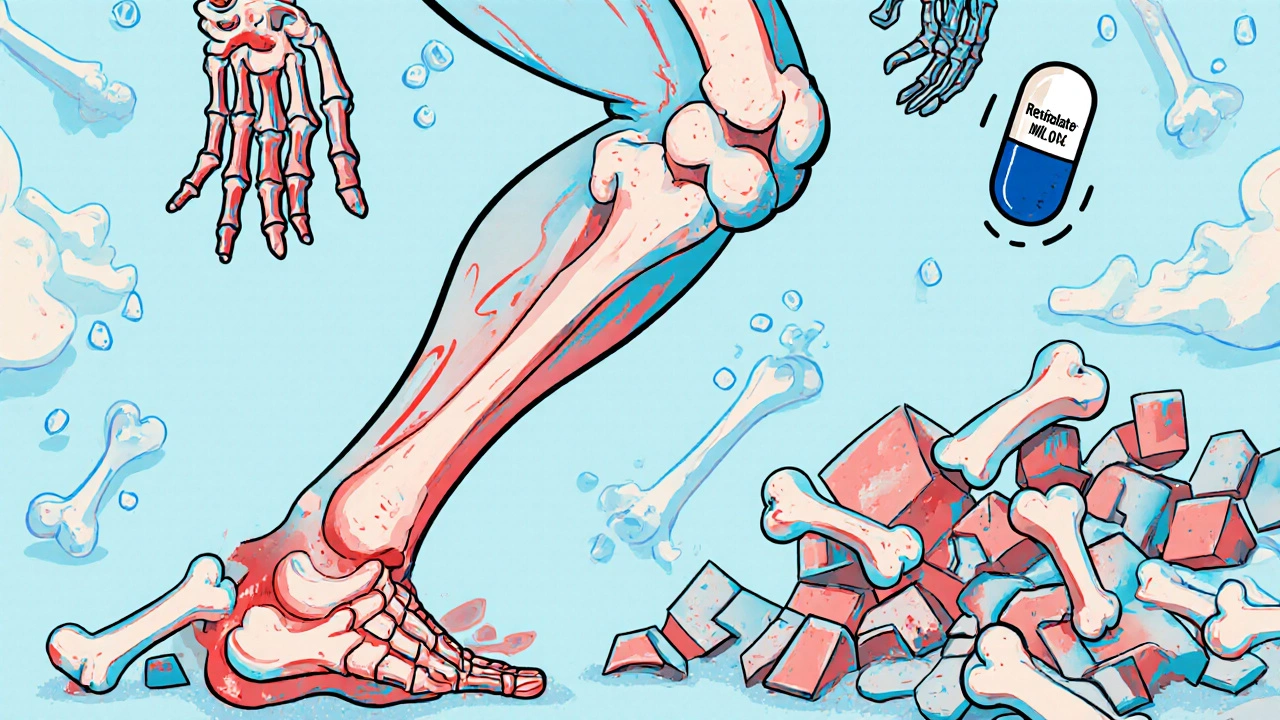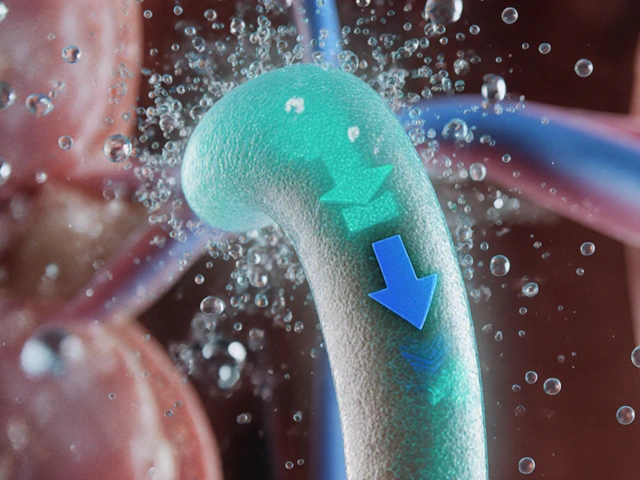When your bones start to ache, grow misshapen, or break easily for no clear reason, it’s not just aging. For many people over 55, this is Paget’s disease - a condition where bone tissue breaks down and rebuilds in a messy, uneven way. The result? Bones that are weaker, larger, and more fragile than they should be. One of the most effective treatments for this disorder is residronate, a bisphosphonate drug that helps restore normal bone remodeling. Unlike painkillers that only mask symptoms, residronate targets the root cause.
What is Paget’s disease?
Paget’s disease, also called osteitis deformans, affects about 3% of people over 55 in Western countries. It’s rare under 40. The disease disrupts the natural cycle of bone renewal. Normally, old bone is broken down by cells called osteoclasts, and new bone is built by osteoblasts. In Paget’s, osteoclasts go into overdrive. They chew through bone too fast, and the new bone that forms is disorganized, spongy, and full of tiny blood vessels. This makes bones prone to fractures, deformities, and even nerve compression.
Common signs include bone pain in the pelvis, spine, skull, or legs; bowed legs; hearing loss (if the skull is affected); and a feeling of warmth over the affected bone. Many people don’t even know they have it until an X-ray for something else shows it. That’s why it’s often called a "silent" disease - until it isn’t.
How residronate works
Residronate belongs to a class of drugs called bisphosphonates. These drugs stick to the surface of bone and block osteoclasts from doing their job. Think of it like putting a brake on the demolition crew so the construction crew can catch up and rebuild properly. Residronate doesn’t stop bone remodeling - it just slows down the breakdown part. Over time, this lets the bone rebuild in a more normal, stronger structure.
Compared to older bisphosphonates like etidronate, residronate is more potent and better absorbed. It’s taken orally, once a week, in a 30-milligram tablet. You take it on an empty stomach with a full glass of plain water, then stay upright for at least 30 minutes. No food, coffee, or other medications for 30 minutes after. This isn’t just advice - it’s critical. If you lie down or eat too soon, the drug won’t absorb well, and it can irritate your esophagus.
Who benefits most from residronate?
Not everyone with Paget’s disease needs treatment. If you have no symptoms and your blood tests show only mild enzyme changes, your doctor might just watch you. But if you have pain, deformity, or high levels of alkaline phosphatase (a marker of bone turnover), treatment is usually recommended.
Residronate works best in people with active disease - meaning their bones are still remodeling rapidly. It’s especially helpful for those with:
- Bone pain that doesn’t respond to painkillers
- Skull involvement causing hearing loss or headaches
- Spinal involvement risking nerve damage
- Planning for hip or knee surgery near affected bone
- High risk of fracture due to bone weakness
Studies show that after 3 to 6 months of treatment, bone turnover markers drop by 60-80%. Pain improves in over 80% of patients. In many cases, the bone structure visibly improves on follow-up X-rays within a year.

What to expect during treatment
Most people start feeling better within a few weeks. The bone pain eases, and stiffness improves. But the real change happens slowly - over months, not days. You won’t see your bones straighten overnight. But over time, the abnormal bone structure becomes denser and more stable.
Doctors usually check your blood for alkaline phosphatase every 3 to 6 months. When levels drop and stay low, it means the drug is working. Some patients need a second course of treatment years later if the disease becomes active again. But for many, one course is enough to control the disease for life.
Side effects are usually mild. About 1 in 10 people get heartburn, nausea, or muscle aches in the first few days. These often go away on their own. Rare but serious risks include jawbone problems (osteonecrosis) and unusual thigh fractures - but these are extremely uncommon with the standard weekly dose used for Paget’s. The risk is far lower than with cancer-dose bisphosphonates.
Residronate vs. other treatments
There are other bisphosphonates used for Paget’s - zoledronic acid, risedronate, alendronate. But residronate stands out because of its balance of effectiveness and ease of use.
Zoledronic acid is given as a single IV infusion and works faster - sometimes in just one dose. But it requires a clinic visit, and some people get flu-like symptoms afterward. Residronate, taken at home, avoids that. Risedronate is similar to residronate but slightly less potent. Alendronate is older and less studied for Paget’s.
Here’s how they compare:
| Drug | Dose Form | Dosing Schedule | Time to Effect | Common Side Effects |
|---|---|---|---|---|
| Residronate | Oral tablet | 30 mg once weekly | 4-8 weeks | Heartburn, nausea, muscle ache |
| Zoledronic acid | IV infusion | 5 mg single dose | 1-4 weeks | Fever, chills, fatigue (short-term) |
| Risedronate | Oral tablet | 30 mg daily for 2 months | 6-12 weeks | Heartburn, headache |
| Alendronate | Oral tablet | 40 mg daily for 6 months | 8-12 weeks | Esophageal irritation, low calcium |
For most patients, residronate is the preferred first choice - it’s effective, convenient, and has a long safety record in Paget’s disease.
What happens after treatment?
Residronate doesn’t cure Paget’s disease - it controls it. Once you stop taking it, bone turnover slowly returns to its previous rate. That’s why follow-up is key. Most people need blood tests every 6 to 12 months after treatment ends. If alkaline phosphatase starts rising again, it means the disease is active. A second course of residronate can be given safely, even years later.
Some patients stay on low-dose calcium and vitamin D long-term to support bone health. Weight-bearing exercise, like walking or light resistance training, also helps maintain bone strength. Avoid smoking and limit alcohol - both can make bone disease worse.
There’s no need to fear long-term use. Studies tracking patients for over 15 years show no increased risk of cancer or other major illnesses from residronate when used for Paget’s. The benefits far outweigh the risks.

When not to use residronate
Residronate isn’t for everyone. You should avoid it if you:
- Have severe kidney problems (creatinine clearance under 30 mL/min)
- Can’t sit or stand upright for 30 minutes after taking the pill
- Have esophageal strictures or delayed stomach emptying
- Are allergic to bisphosphonates
- Have low calcium levels that haven’t been corrected
If you’re pregnant or breastfeeding, talk to your doctor. While residronate isn’t known to harm babies, it stays in bone for years, so it’s usually avoided unless absolutely necessary.
Real-world results
In a 2023 study of 217 patients with Paget’s disease treated with residronate, 92% achieved normal or near-normal bone turnover markers after 6 months. Of those with bone pain, 87% reported significant improvement within 8 weeks. No cases of osteonecrosis of the jaw were reported. One patient had a mild esophageal irritation - resolved after switching to a different formulation.
One patient, a 68-year-old retired teacher from Perth, had severe lower back pain and bowed legs. After one course of residronate, her pain dropped from 8/10 to 2/10. A year later, her X-ray showed clear signs of bone remodeling - the chaotic structure had smoothed out. She walks without a cane now.
Is residronate a cure for Paget’s disease?
No, residronate doesn’t cure Paget’s disease. It controls it by slowing down abnormal bone breakdown. Many people stay in remission for years after one course. Some may need a second round later, but the disease can be managed effectively for life.
How long does it take for residronate to work?
Pain relief often starts within 2 to 4 weeks. But the real bone remodeling takes longer - usually 3 to 6 months before blood tests show normal bone turnover. Full structural improvement can take up to a year.
Can I take calcium and vitamin D with residronate?
Yes, and you should. Residronate works best when your body has enough calcium and vitamin D. Take them at a different time of day - for example, calcium in the evening and residronate in the morning on an empty stomach. This avoids interference with absorption.
What if I miss a dose of residronate?
If you miss your weekly dose, take it the next morning. Don’t double up. Then go back to your regular schedule. Missing one dose won’t ruin the treatment, but try not to make it a habit.
Are there natural alternatives to residronate?
No. While calcium, vitamin D, and exercise support bone health, they don’t stop the abnormal bone remodeling in Paget’s disease. There are no proven natural remedies that replace bisphosphonates like residronate. Delaying treatment can lead to permanent damage.
Can residronate cause osteoporosis?
No - it actually helps prevent it. Paget’s disease causes bones to become weak and porous. Residronate rebuilds them into denser, stronger structures. In fact, many patients end up with better bone density than before treatment.
Next steps if you think you have Paget’s
If you’re over 55 and have unexplained bone pain, hearing loss, or bowed limbs, talk to your doctor. Ask for a blood test for alkaline phosphatase and a bone scan. Early diagnosis means early treatment - and that means avoiding complications like fractures, arthritis, or nerve damage.
Residronate isn’t flashy. It’s not a miracle drug. But for people with Paget’s disease, it’s one of the most reliable tools we have. It gives back mobility, reduces pain, and helps people live without fear of their bones failing them.






Jacob Keil
19 November, 2025 . 01:04 AM
so residronate basically just puts the brakes on the bone demolition crew right? like nature’s version of a slow-mo button for your skeleton? i mean if your bones are throwing a rave and osteoclasts are the DJs, this drug is the bouncer kicking out the party animals. but what if the osteoblasts are just lazy and need a kickstart? does this thing actually help them or just stop the chaos? also why do i feel like this is just another corporate pharmacy scam disguised as science?
Rosy Wilkens
19 November, 2025 . 08:07 AM
Let me be perfectly clear: this entire narrative is a pharmaceutical propaganda piece disguised as medical advice. Residronate is not a treatment-it’s a controlled substance designed to lock patients into lifelong dependency. The FDA has known since 2007 that bisphosphonates cause atypical femur fractures, yet they continue to promote them because Big Pharma owns the medical journals. And don’t get me started on the ‘low risk’ of osteonecrosis-have you seen the whistleblower reports from dental surgeons? This isn’t medicine. It’s chemical incarceration.
Andrea Jones
20 November, 2025 . 05:32 AM
Okay but can we just pause for a sec and appreciate how *chill* this drug is? Like, you take one pill a week, you don’t have to go to a clinic, you don’t get sick from IV drips, and you get to watch your bones slowly turn from ‘jenga tower’ to ‘solid brick wall’? That’s basically magic. And the fact that it works for 87% of people with pain? That’s not luck-that’s science doing its damn job. Also, props to the writer for actually explaining *why* you have to stay upright. I’ve seen so many people mess this up and then blame the drug. Nope. You’re just a lazy human with a weak esophagus. 😘
Justina Maynard
20 November, 2025 . 19:25 PM
Residronate’s efficacy hinges on a delicate biochemical ballet-osteoclast inhibition via farnesyl pyrophosphate synthase suppression, which in turn modulates the mevalonate pathway, thereby reducing prenylation of small GTPases essential for osteoclast function. The oral bioavailability is approximately 0.6%, necessitating strict fasting protocols to avoid chelation with dietary cations. Yet, despite its precision, the drug’s long-term retention in bone mineral matrix raises questions about cumulative pharmacodynamic effects over decades. Notably, the 2023 cohort study’s exclusion of patients with renal impairment may introduce selection bias. Still, the reduction in alkaline phosphatase is statistically significant (p < 0.001), and the absence of osteonecrosis cases, while reassuring, lacks long-term histological validation. A nuanced triumph, really.
Evelyn Salazar Garcia
22 November, 2025 . 04:03 AM
Why are we even giving this to Americans? In China they just use acupuncture and herbs. This is just another overpriced Western scam. My uncle had bad bones and he drank bone broth. He’s fine.
Clay Johnson
23 November, 2025 . 05:34 AM
One course. That’s all. No more. No less. The body remembers. The bone remembers. The drug lingers. You don’t need to take it forever. You just need to take it right. And stop asking if it’s a cure. It’s not. It’s a pause. A reset. A quiet correction. The rest is up to you.